Blackberries contain ten powerful antioxidants that’ll protect your DNA from damage. Anthocyanins and cyanidin-3-glucoside form your primary defense, neutralizing free radicals and activating repair pathways. Ellagic acid provides over 75% free radical scavenging, while protocatechuic acid prevents DNA damage before it occurs. Vitamin C, gallic acid, quercetin, catechins, rutin, and phloroglucinol aldehyde complete this protective arsenal by enhancing repair mechanisms and strengthening cellular defenses. These compounds work synergistically to maximize your body’s natural DNA protection capabilities.
Anthocyanins: The Primary DNA-Protective Compounds in Blackberries

Deep purple pigments called anthocyanins give blackberries their rich color while serving as powerful guardians of your DNA. These compounds protect your genetic material through multiple mechanisms, including neutralizing free radicals that cause oxidative stress and potentially binding directly to DNA strands through intercalation.
Anthocyanins in blackberries act as molecular bodyguards, shielding your DNA from oxidative damage through powerful antioxidant mechanisms.
You’ll find anthocyanins particularly effective at shielding your cells from DNA damage caused by certain drugs like camptothecin and doxorubicin. They work by transferring hydrogen atoms and electrons to neutralize harmful molecules before they can damage your cellular structure.
While anthocyanins have relatively low bioavailability in your bloodstream, they remain highly active in your gastrointestinal tract. Research on HT29 colon carcinoma cells demonstrates that cyanidin-3-glucoside specifically reduces DNA-damaging effects from topoisomerase poisons.
In cancer research, these compounds show promise by inhibiting abnormal cell proliferation and interfering with topoisomerase activity, which is essential for DNA replication processes.
Cyanidin-3-Glucoside: Blackberry’s Most Potent Antioxidant for Cellular Repair
While blackberries contain multiple anthocyanins, cyanidin-3-glucoside (C3G) stands out as the most abundant and powerful compound for DNA protection, comprising roughly 80% of the fruit’s total anthocyanin content.
| C3G Benefits | How It Works |
|---|---|
| DNA Strand Break Repair | Activates PARS pathways for cellular repair |
| Mitochondrial Protection | Maintains energy metabolism under stress |
| Antioxidant Defense | Neutralizes peroxynitrite and reactive species |
| Metabolic Support | Improves glucose consumption and glycogen storage |
You’ll find C3G’s protective effects extend beyond direct antioxidant activity. Your gut microbiota transforms this compound into bioactive metabolites that retain protective properties, supporting systemic DNA repair mechanisms. These metabolites continue fighting oxidative stress in your liver cells while promoting cellular homeostasis throughout your body. Research demonstrates that C3G shows excellent analytical performance as a biomarker, with studies confirming its stability and dose-response relationship in human plasma and urine samples.
Protocatechuic Acid: Supporting DNA Strand Break Recovery
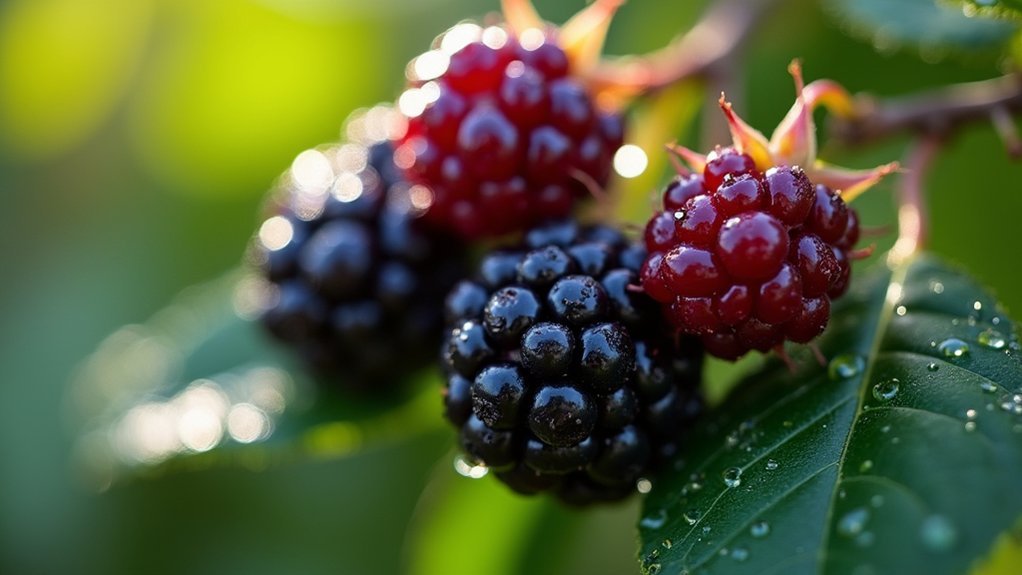
Protocatechuic acid (PCA) works differently than cyanidin-3-glucoside, targeting DNA protection through a specialized mechanism that prevents damage before it occurs.
You’ll find PCA reduces DNA adduct formation caused by carcinogenic metabolites like dibenzo[a,l]pyrene diol in your cells. This compound limits mutagenesis by preventing mutation initiation from carcinogen exposure rather than repairing existing damage.
PCA’s molecular structure lets it interact with reactive carcinogen intermediates, lowering their capacity to damage DNA strands. The compound demonstrates high permeability across cellular membranes, allowing it to reach target tissues effectively for protective action.
You won’t see PCA strongly affecting chemotherapy-induced DNA damage like other blackberry antioxidants do. Instead, it focuses on chemical detoxification of mutagens.
While PCA doesn’t directly stimulate enzymatic repair, it complements other blackberry compounds by targeting specific DNA damage pathways related to adduct formation.
Phloroglucinol Aldehyde: Enhancing Oxidative Stress Defense
When you consume blackberries, phloroglucinol aldehyde forms through natural metabolic processes that transform the fruit’s phenolic compounds into this potent antioxidant derivative.
Your cells benefit from this compound’s exceptional ability to neutralize reactive oxygen species while simultaneously boosting glutathione levels and activating key antioxidant enzymes like glutathione peroxidase.
This dual-action mechanism doesn’t just prevent oxidative damage—it actively restores your cellular defenses to ideal levels, creating an environment where DNA repair processes can function more effectively. The compound shares structural similarities with phloroglucinol, a phenol derivative known for its antioxidant properties in various applications.
PGA Formation Process
As your body processes blackberry anthocyanins during digestion, it creates phloroglucinol aldehyde (PGA) through a sophisticated metabolic transformation that enhances your natural oxidative stress defenses.
This formation involves the systematic degradation of polyphenols, specifically anthocyanins, converting them into bioactive metabolites that appear in your plasma.
The PGA formation process utilizes your body’s enzymatic pathways to break down complex polyphenol structures into smaller, more bioavailable compounds.
This metabolic conversion doesn’t just create waste products—it generates powerful antioxidant molecules that actively scavenge free radicals in your cellular systems. Laboratory synthesis of phloroglucinol compounds typically involves reflux condensers to control temperature and maintain optimal reaction conditions.
Your body’s ability to produce PGA from blackberry consumption demonstrates how anthocyanin-rich foods contribute to cellular protection mechanisms, providing sustained antioxidant benefits that support your DNA repair processes.
Cellular Protection Mechanisms
Once your body transforms blackberry anthocyanins into phloroglucinol aldehyde (PGA), this powerful metabolite launches an extensive cellular defense system that directly protects your DNA from oxidative damage. PGA activates your Nrf2/HO-1 antioxidant pathway, enhancing cellular defenses against DNA-damaging reactive oxygen species.
| Protection Mechanism | Target Effect | Cellular Outcome |
|---|---|---|
| ROS Scavenging | Neutralizes free radicals | Prevents DNA oxidation |
| Nrf2 Activation | Enhances antioxidant genes | Strengthens cellular defense |
| Catalase Restoration | Restores enzyme activity | Improves ROS neutralization |
| Mitochondrial Defense | Preserves organelle function | Reduces cellular apoptosis |
| HO-1 Upregulation | Increases protective proteins | Enhances DNA repair capacity |
Your cells respond by producing higher levels of catalase and glutathione peroxidase, critical enzymes that neutralize harmful oxidants before they can damage your DNA structure and trigger dangerous mutations. This protective mechanism proves particularly effective in human keratinocytes, where PGA demonstrates significant therapeutic potential for preventing oxidative stress-induced cellular damage.
Antioxidant Potency Effects
Something remarkable happens with phloroglucinol aldehyde’s antioxidant capacity—it doesn’t just neutralize free radicals but fundamentally reshapes your cellular defense architecture against oxidative stress.
You’ll experience enhanced glutathione levels and boosted enzyme activities like GPx and GR, creating a robust protective network within your cells. Unlike simple antioxidants that work in isolation, phloroglucinol aldehyde actively reduces ROS levels while maintaining idea cell viability. The compound also demonstrates anti-carbonyl capacity against toxic reactive aldehydes that can damage cellular components.
Research shows diacylphloroglucinol derivatives demonstrate superior antioxidant activity compared to monomers, suggesting you’re getting enhanced potency.
This compound’s effectiveness extends beyond standard FRAP and TEAC measurements—it’s measurably strengthening your body’s natural oxidative stress defense mechanisms, making it particularly valuable for DNA repair processes.
Ellagic Acid: Neutralizing Free Radicals That Damage DNA
Your cells face constant assault from free radicals that can wreak havoc on your DNA, but ellagic acid in blackberries acts as a powerful shield against this damage.
This potent polyphenol doesn’t just sit passively—it actively hunts down reactive oxygen species and neutralizes them before they can attack your genetic material.
When you consume blackberries rich in ellagic acid, you’re fundamentally deploying a cellular defense system that scavenges harmful molecules and prevents the oxidative stress that leads to DNA breaks and mutations. Research shows that ellagic acid treatment induces ROS generation and alters mitochondrial dynamics, leading to DNA damage and apoptosis in cancer cells.
Free Radical Scavenging Power
When free radicals attack your cells, ellagic acid in blackberries acts as a powerful shield, neutralizing these destructive molecules before they can damage your DNA. This remarkable antioxidant achieves over 75% free radical scavenging at concentrations between 0.8-100 µg/ml, demonstrating exceptional protective capacity.
Ellagic acid’s scavenging power works through multiple mechanisms:
- Hydrogen atom transfer – EA donates hydrogen atoms from its hydroxyl groups to neutralize radicals
- Radical adduct formation – It directly binds to reactive species, rendering them harmless
- Sequential electron transfer – EA anions participate in sophisticated neutralization pathways under physiological conditions
With an IC50 value below 4.0 µg/ml for lipid peroxidation inhibition, ellagic acid outperforms many synthetic antioxidants in protecting your cellular membranes and DNA from oxidative damage. Studies show that ellagic acid’s antioxidant efficacy surpasses that of vitamin E in protecting against cellular damage from reactive oxygen species.
DNA Protection Mechanisms
Beyond neutralizing free radicals, ellagic acid activates sophisticated DNA protection mechanisms that actively repair and prevent genetic damage in your cells.
This polyphenol derived from ellagitannins increases the expression of DNA repair genes, enhancing your body’s natural ability to fix oxidative damage. Studies show that red raspberry and ellagic acid diets markedly reduce DNA adducts – harmful compounds that bind to your DNA and cause mutations.
You’ll benefit from ellagic acid’s dual action: it prevents DNA damage through antioxidant properties while simultaneously boosting repair mechanisms.
At specific concentrations, it’s highly effective in reducing endogenous oxidative DNA damage. This compound neutralizes oxidative agents before they reach your genetic material, creating a protective shield around your cells’ most essential components. Research platforms now provide enhanced visibility of studies demonstrating ellagic acid’s protective effects on cellular DNA.
Cellular Damage Prevention
Ellagic acid functions as a powerful antioxidant that directly neutralizes free radicals before they can inflict damage on your DNA.
This polyphenolic compound’s unique structure enables it to scavenge reactive oxygen species (ROS) that would otherwise create harmful oxidative DNA adducts through hydroxyl radical formation.
Your cells benefit from ellagic acid’s extensive protective mechanisms:
- Direct free radical neutralization – It intercepts and neutralizes ROS before they reach your DNA
- Metal ion protection – It prevents CuCl2-induced oxidative damage and estrogen-related oxidative stress
- Membrane integrity preservation – It inhibits lipid peroxidation, reducing secondary DNA damage
Quercetin: Boosting Natural DNA Repair Mechanisms
Among the many flavonoids found in blackberries, quercetin stands out as a particularly potent antioxidant that directly enhances your body’s natural DNA repair mechanisms. At concentrations between 1-100 µM, quercetin doesn’t just neutralize free radicals—it actively modulates your DNA repair enzyme expression, significantly increasing hOGG1 mRNA levels.
When your cells face oxidative stress, quercetin maintains or elevates hOGG1 enzyme expression for up to 12 hours, enhancing repair of oxidative DNA lesions like 8-oxoguanine. As a phenolic compound, quercetin joins other natural substances being researched for their ability to target DNA repair pathways in therapeutic applications.
You’ll see measurable decreases in 8-hydroxydeoxyguanosine levels, a key marker of DNA damage. This dual action—preventing oxidative damage while boosting repair pathways—makes quercetin exceptionally effective at protecting your genetic material from environmental stressors and cellular aging processes.
Vitamin C: Strengthening Antioxidant Networks for Genetic Protection
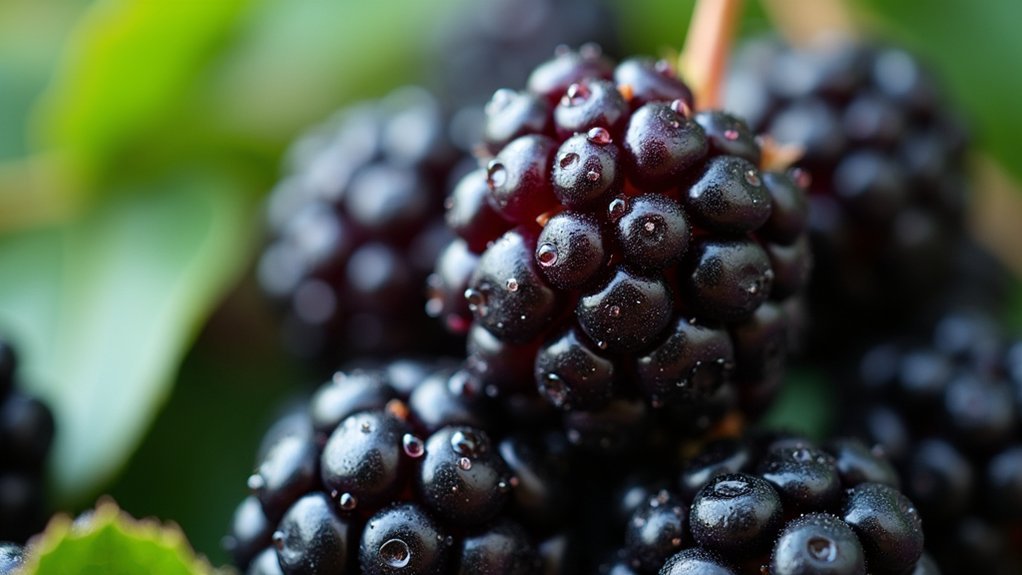
While quercetin works through specific enzymatic pathways, vitamin C operates as the cornerstone of your cellular antioxidant network, providing extensive genetic protection through multiple interconnected mechanisms.
Your body’s vitamin C acts as a powerful shield against DNA damage by directly neutralizing reactive oxygen species before they can harm your genetic material. It reduces formation of dangerous DNA markers like 8-oxodG while stimulating repair enzyme expression.
Vitamin C strengthens your genetic defenses through three key actions:
- Scavenging harmful oxidants – It intercepts hydrogen peroxide and other damaging molecules.
- Enhancing repair mechanisms – It activates nucleotide excision repair pathways for damaged DNA.
- Balancing cellular stress – It temporarily increases beneficial stress signals that prime your repair systems.
This dual antioxidant-pro-oxidant balance maximizes your cellular protection and genomic stability. The nervous system particularly benefits from vitamin C’s protective effects, as intracellular concentrations can reach up to 10 mM in neurons, providing enhanced antioxidant defense where it’s needed most.
Gallic Acid: Preventing Oxidative DNA Damage at the Cellular Level
Beyond vitamin C’s network-strengthening effects, gallic acid targets oxidative DNA damage through a more specialized cellular approach. This trihydroxybenzoic acid works directly at the cellular level by reducing oxidized purines and pyrimidines in your DNA strands.
You’ll benefit from gallic acid’s dual protection mechanism. It activates essential antioxidant enzymes like superoxide dismutase and glutathione peroxidase while simultaneously decreasing harmful ROS concentrations in your lymphocytes.
Human trials demonstrate that just 15mg daily—equivalent to typical Central European intake—significantly reduces DNA oxidation markers.
Your cells gain enhanced protection against oxidative stress through gallic acid’s ability to activate transcription factors and reduce inflammatory mediators like TNF-α. This compound also exhibits antibacterial effects against common pathogens including E. coli and Staphylococcus aureus. This targeted approach helps prevent cancer, supports cardiovascular health, and protects against diabetes-related oxidative damage.
Catechins: Supporting Topoisomerase Function and DNA Stability
Catechins enhance DNA stability through their sophisticated interaction with topoisomerase enzymes, which are essential for maintaining chromosome integrity during replication and transcription.
These powerful antioxidants work by reducing oxidative stress that can compromise topoisomerase function and DNA structural integrity. Catechins represent 30%-40% of dry tea leaves, making green tea an exceptional source for supporting genomic protection.
Your cells benefit from catechins’ multifaceted approach to genomic protection:
- Direct radical scavenging – They neutralize free radicals before they can damage DNA strands or interfere with enzymatic processes.
- Metal ion chelation – Catechins bind harmful metal ions that could initiate oxidative reactions affecting chromosome stability.
- Antioxidant enzyme induction – They boost your cellular antioxidant defenses while inhibiting pro-oxidant enzymes.
Rutin: Amplifying Blackberry’s Overall Antioxidant Capacity
Rutin represents another powerful component in blackberry’s antioxidant arsenal, working alongside catechins to create a thorough defense system for your cellular DNA. This flavonoid glycoside excels at scavenging free radicals and chelating metals that trigger oxidative stress.
You’ll find rutin particularly effective against hydroxyl radicals, which pose significant threats to DNA integrity.
What makes rutin especially valuable is its synergistic relationship with other blackberry compounds like anthocyanins and quercetin. Together, they amplify your body’s overall antioxidant capacity beyond what individual compounds achieve alone.
Rutin’s antimutagenic effects help reduce DNA mutations while supporting cellular homeostasis. Its enhanced bioavailability compared to other flavonoids means more protection reaches your target tissues, maximizing DNA repair support. Blackberry leaves demonstrate superior lipid peroxidation inhibition at 24.86% compared to other berry varieties, indicating enhanced protection against cellular membrane damage.
Frequently Asked Questions
How Much Blackberry Should I Eat Daily for Optimal DNA Repair Benefits?
You’ll get ideal DNA repair benefits from eating one cup of raw blackberries daily. This provides 30.2mg vitamin C and high anthocyanin levels that’ll protect your cells from oxidative damage effectively.
Are Frozen Blackberries as Effective as Fresh Ones for Antioxidant Activity?
You’ll get nearly identical antioxidant activity from frozen blackberries compared to fresh ones. Freezing preserves most nutrients and bioactive compounds, so you won’t lose the DNA repair benefits you’re seeking.
Can Blackberry Supplements Replace Eating Whole Berries for DNA Protection?
You can’t fully replace whole berries with supplements for DNA protection. While supplements provide concentrated antioxidants, they lack the synergistic effects of fiber, vitamins, and complete phytochemical profiles that whole blackberries offer.
Do Cooking or Processing Blackberries Reduce Their DNA Repair Properties?
Yes, you’ll lose DNA repair benefits when you cook blackberries since heat degrades their protective polyphenols and anthocyanins. You should eat them fresh or use gentle processing methods to preserve these compounds.
How Long Does It Take to See DNA Protective Effects From Blackberries?
You’ll likely see immediate free radical scavenging effects from blackberry antioxidants, but significant DNA protective benefits may take weeks to months of consistent consumption, depending on your individual metabolism and dosage.
In Summary
You’ll maximize DNA protection by incorporating these ten powerful blackberry antioxidants into your diet. From anthocyanins and cyanidin-3-glucoside to vitamin C and rutin, each compound works synergistically to repair cellular damage and neutralize harmful free radicals. You can’t go wrong adding blackberries to your daily routine—they’re nature’s all-encompassing defense system against oxidative stress. Start enjoying these nutrient-dense berries today and give your cells the antioxidant support they need for ideal genetic health.


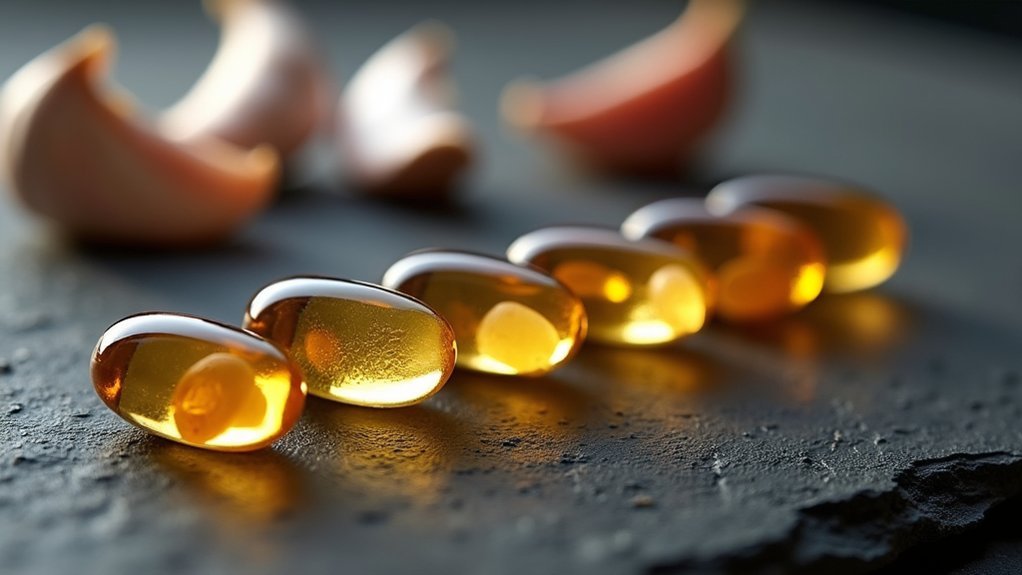
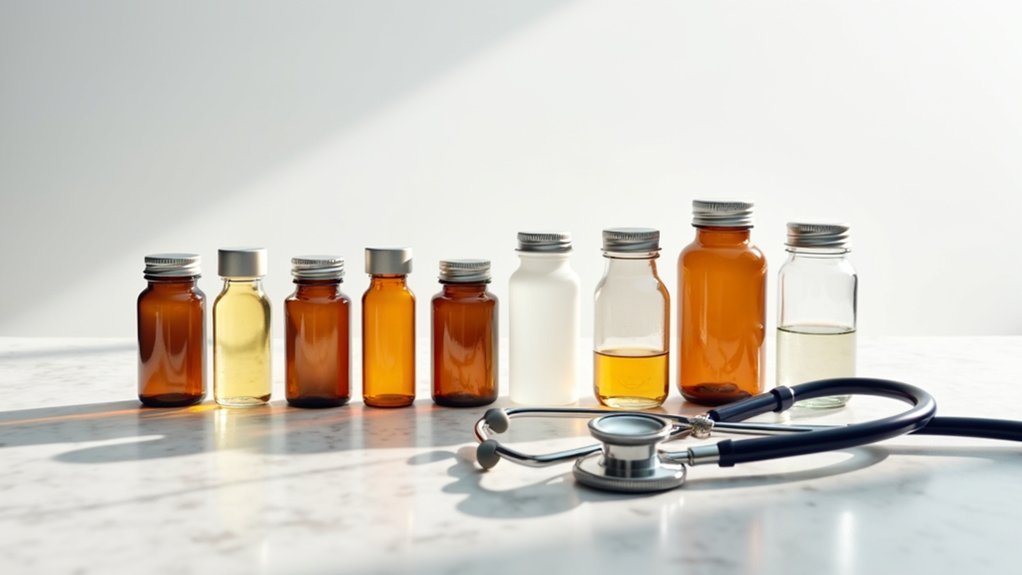
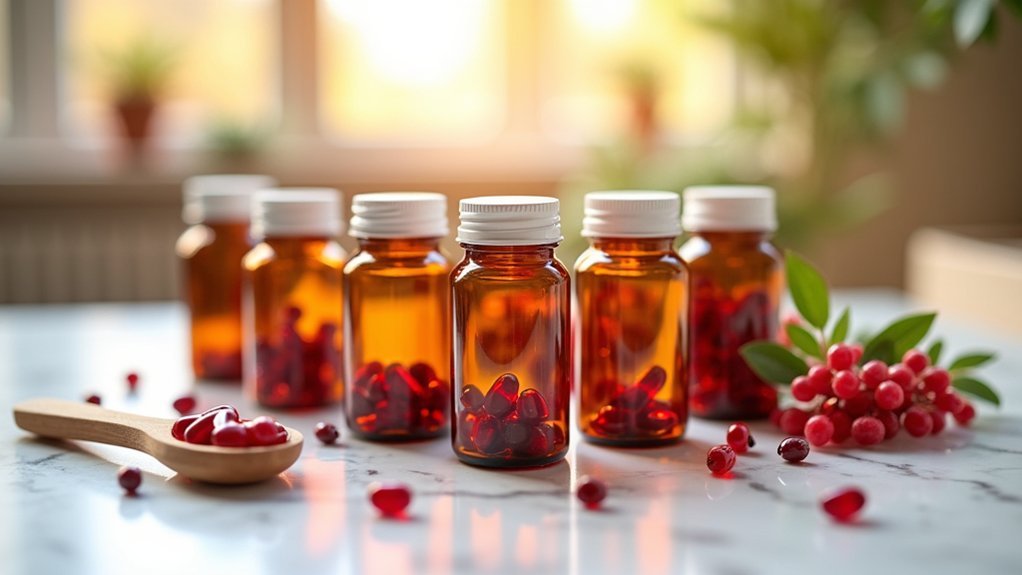
Leave a Reply